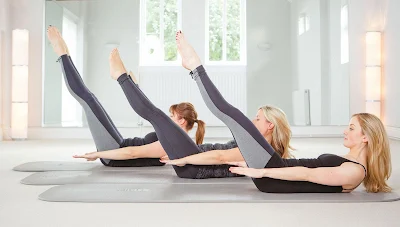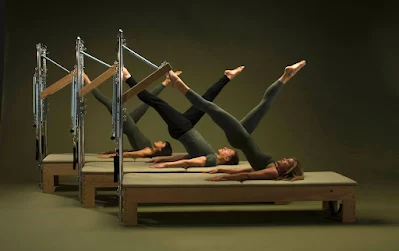Pilates: what it is and what it is for
The Pilates method is a form of exercise that has gained popularity around the world due to its health and well-being benefits.
Developed by Joseph Pilates in the early 20th century, this approach to fitness has become one of the most chosen options for those looking to improve their strength, flexibility and balance, while working on their mind and body in an integrated way. .
See How to live a good life in 7 steps
In this article, we will explore in depth what Pilates is and what it is for, highlighting its principles, benefits and who can benefit from this discipline.
 |
| Pilates: what it is and what it is for |
History and foundations of the Pilates Method
Joseph Pilates, a German who suffered from various illnesses in his youth, developed the Pilates method as a comprehensive system of physical and mental conditioning. During World War I, he worked in a hospital where he helped rehabilitate injured soldiers using exercises that would later become an integral part of Pilates. Inspired by his experiences, Pilates devised an exercise system that focused on breathing, control, concentration, center, precision and fluidity.
The six principles of Pilates:
- Breathing: In Pilates, breathing plays a crucial role. Deep, controlled breathing is promoted, which allows adequate oxygenation of the muscles and the elimination of toxins.
- Control: Every movement in Pilates is performed with precision and control. The mind must be completely present in each action, avoiding sudden or uncontrolled movements.
- Concentration: Concentration is essential for success in Pilates. Full attention to each movement is required to achieve maximum benefits.
- Core: The core, also known as the “powerhouse,” refers to the muscles of the abdomen, lower back, and glutes. In Pilates, we work on strengthening and stabilizing this area, which is essential for good balance and proper posture.
- Precision: Precision is essential in Pilates. Movements must be performed accurately to avoid injuries and achieve the desired results.
- Fluidity: Pilates is characterized by soft and fluid movements that connect one with another. This fluidity improves flexibility and coordination.
Benefits of Pilates
The Pilates method offers a wide range of benefits, both physical and mental. Below are some of the main ones:
1. Improves strength and flexibility
Pilates exercises work on the strength of the main and secondary muscles, which helps to develop strong and toned muscles. Additionally, flexibility is emphasized through movements that stretch and elongate muscles, improving range of motion in the joints.
2. Improves posture
Pilates focuses on body alignment and postural awareness. By strengthening the core muscles, muscle imbalances that can cause poor posture are corrected, which in turn reduces the likelihood of back and neck pain.
3. Increase body awareness
The Pilates method promotes the mind-body connection. The exercises are performed with full attention to each movement, which increases body awareness and coordination.
4. Relieves stress
The concentration and deep breathing used in Pilates help reduce stress and anxiety. By focusing on the present moment and the movements, daily worries tend to dissipate.
5. Rehabilitation
Pilates is used in the rehabilitation of muscle and joint injuries. Many physical therapists incorporate Pilates exercises into their recovery programs to strengthen affected muscles and restore functionality.
6. Increased energy
Regular Pilates practice increases blood circulation and improves breathing, leading to increased energy and vitality.
7. Promotes weight loss
While Pilates is not an intense cardiovascular exercise, it can be part of an effective weight loss program. By improving strength and lean muscle mass, Pilates can increase metabolism and help burn calories more efficiently.
Who is Pilates for?
Pilates is a versatile discipline that can be adapted for people of all ages and fitness levels. Some of the groups that can benefit from Pilates include:
1. Beginners
Pilates is suitable for beginners as the exercises can be adapted to suit any fitness level. Pilates instructors often offer beginner options that allow you to gradually progress to more advanced movements.
2. Athletes
Many athletes incorporate Pilates into their training programs to improve their strength, flexibility, and athletic performance. Pilates movements can complement other sports by addressing muscle imbalances and preventing injuries.
3. Seniors
Pilates is a safe and effective option for older adults who want to maintain their strength, balance and mobility as they age. It can help prevent falls and improve quality of life in the elderly.
4. Pregnant women
Pilates can be beneficial for pregnant women as it helps strengthen core muscles and relieve tension in the back and pelvis. However, it is important to perform Pilates exercises designed specifically for pregnant women and under the supervision of a professional.
5. People in rehabilitation
Pilates is used in the rehabilitation of muscle and joint injuries, as movements can be adapted to target affected areas and strengthen weakened muscles. It is commonly used by physical therapists as part of a rehabilitation program.
6. People with back problems
Pilates is known for its ability to relieve back pain and improve posture. Those who suffer from back problems, such as a herniated disc or scoliosis, can find relief and strengthening through regular Pilates practice.
7. People looking to reduce stress
Pilates emphasizes concentration and deep breathing, making it a great option for those looking to reduce stress and improve mental health. Regular Pilates practice can help relieve anxiety and promote relaxation.
8. Anyone interested in general well-being
In short, Pilates is suitable for anyone interested in improving their overall well-being, regardless of their fitness level or age. Exercises can be customized to suit individual needs, making it a versatile and accessible option for a wide variety of people.
It is always advisable to consult a Pilates professional or doctor before beginning an exercise program, especially if you have any health concerns or a pre-existing medical condition. A certified Pilates instructor can design a customized program to fit your specific goals and needs.





Comments
Post a Comment